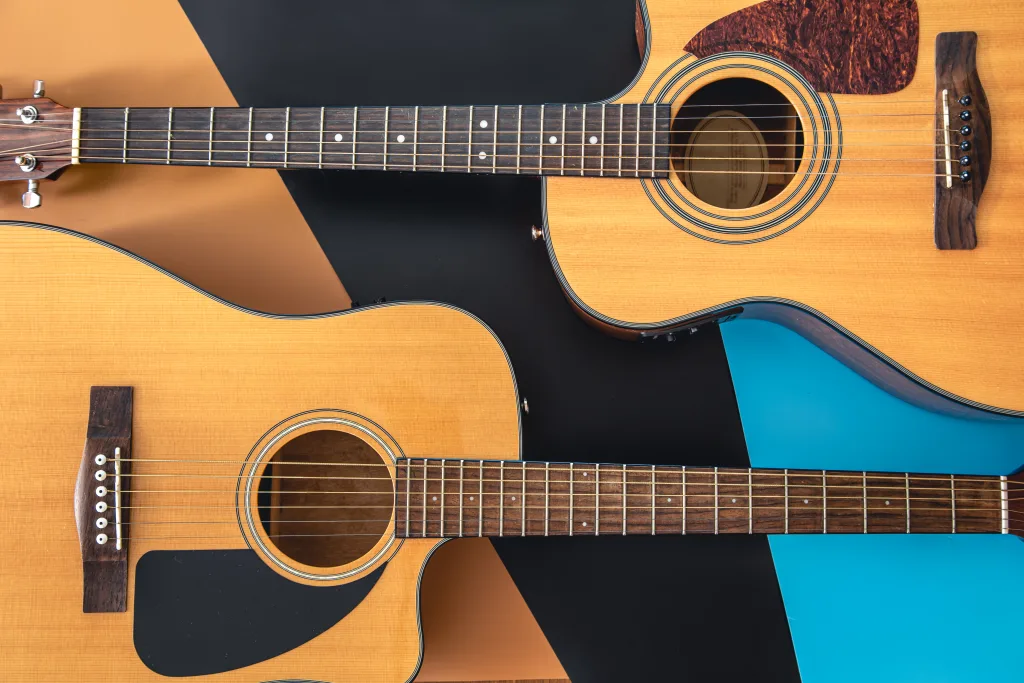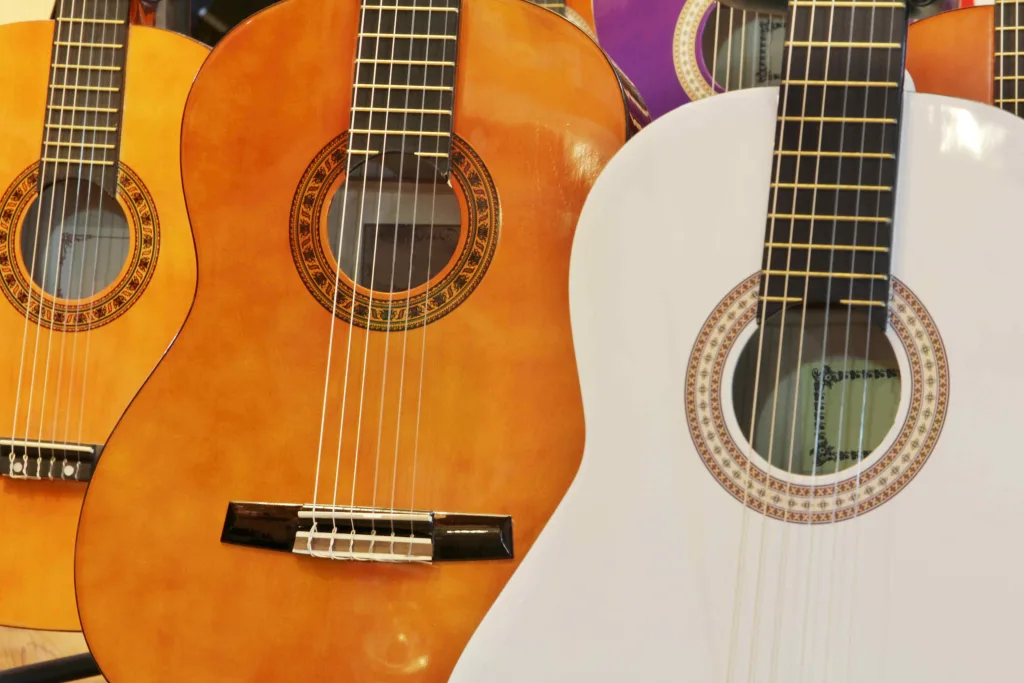The Spanish guitar is a unique instrument with a rich history and a distinctive sound. In this article, we will explore the fascinating world of the Spanish guitar, including its history, construction, different types, and how to choose the right one for you.
What is a Spanish Guitar?
The Spanish guitar, also known as the classical guitar, is a type of acoustic guitar that is strung with nylon strings. It is typically used to play classical music or traditional music of Spanish origin.
The instrument is played by plucking the strings with the fingers rather than using a pick. Spanish guitarists often grow the fingernails of their right hand to achieve a stronger and more controlled sound. The guitar is usually played while seated, with the instrument resting on the performer’s left leg.
The precursors to the modern Spanish guitar were plucked instruments such as the vihuela and the lute, which were strung with gut strings. Today’s Spanish guitars are strung with nylon strings, with the lowest three strings having an additional outer winding of metal.
A Brief History of Spanish Guitar
The Spanish guitar, with its roots tracing back to the Middle Ages, was primarily used as a folk instrument for singing during that time. It has changed and improved over the years, becoming more popular among musicians in Spain and beyond.
A major breakthrough happened in 1846 when Antonio de Torres Jurado created classical and flamenco guitars. These new designs had larger bodies, higher frets, and a device that made it easier to change strings. Since then, Spanish guitars have been used in different types of music like jazz, rock, flamenco, and Latin American styles.
The Sound of a Spanish Guitar
The Spanish guitar has a soft, sweet sound that is highly expressive. The player has a great deal of control over the tone being produced. Various right-hand techniques can substantially alter the timbre of the notes, while left-hand effects such as vibrato, slides, and slurs add a lyrical, song-like quality to melodies.
The top, or front panel, of a Spanish guitar’s body acts as a soundboard, amplifying the vibration of the strings. The wood used for the top has a strong effect on the instrument’s sound. Guitars with spruce tops tend to have a clear, bright sound, while those with cedar tops have a warmer but less defined sound.
The Music of a Spanish Guitar

The music of a Spanish guitar is originally written for instruments such as the lute and the vihuela and is still played by today’s classical guitarists.
One of the most famous pieces of Spanish guitar music is the “Concierto de Aranjuez,” a guitar concerto by Spanish composer Joaquín Rodrigo. Other well-known Spanish guitar composers include Francisco Tárrega, Fernando Sor, Mauro Giuliani, Heitor Villa-Lobos, as well as transcriptions of piano music by Isaac Albéniz and Enrique Granados. The Spanish guitar’s versatility allows it to be used in a wide range of musical styles and genres.
How to Play a Spanish Guitar
Playing the Spanish guitar requires a different technique compared to acoustic guitar playing. Spanish guitarists play the instrument while seated, using their fingers to sound the notes rather than a pick.
The emphasis is on reading written music rather than improvising, although there are exceptions.
Construction of a Spanish Guitar
Spanish guitars are usually crafted using cedar or spruce wood, which provides a delightful and warm sound. The body of the guitar is rectangular in shape and features a hole in the middle that helps project the sound. The neck tapers and has a flat back, making it more comfortable to press down on the strings while playing.
Spanish guitars have higher frets, allowing for more accurate finger placement.
The Body of a Spanish Guitar
The body of the Spanish guitar is the largest part and houses the sound hole, which helps project the sound.
The Neck of a Spanish Guitar
The neck of the Spanish guitar is attached to the body and holds the strings. It is tapered to facilitate playing and fretting.
The Headstock of a Spanish Guitar
The headstock of the Spanish guitar is located at the end of the neck and houses the tuning pegs used to tune the strings.
The Strings of a Spanish Guitar
The strings of the Spanish guitar are six strings and are made of nylon. These strings produce the sound when plucked or strummed.
The Tuning Pegs of a Spanish Guitar
The tuning pegs of the Spanish guitar, found on the headstock, allow the adjustment of string tension for tuning different notes and chords.
Different Types of Spanish Guitars

There are three main types of Spanish guitars: classical guitars, flamenco guitars, and acoustic guitars.
Classical Guitar
Classical guitars are normally used for solo performances due to their softer sound. They are made with high-quality materials like cedar or spruce wood and have nylon strings.
Classical guitars are known for their larger size, which can make them more challenging to transport and store.
Pros:
- Produces a softer sound suitable for solo performances
- Made with high-quality materials
Cons:
- Large sizes can be difficult to transport and store
- Nylon strings may be less durable
Flamenco Guitar
Flamenco guitars are smaller in size, making them more convenient to carry around. They are typically made with cypress wood, which gives them a brighter sound. Flamenco guitars have nylon strings and are commonly used for the traditional musical style of flamenco.
Pros:
- Smaller size makes them easier to transport and store
- Produces a bright and clear sound suitable for flamenco music
Cons:
- Nylon strings may be less durable
Acoustic Guitar
The acoustic guitar is the most common type of Spanish guitar, suitable for a variety of musical genres. It can produce both loud and soft sounds, depending on playing technique. Acoustic guitars are typically made with mahogany or cedar wood and have steel strings.
Pros:
- Versatile, suitable for various genres
- More affordable compared to other types of guitars
Cons:
- May be less durable compared to other types of guitars
How to Choose a Spanish Guitar
When choosing a Spanish guitar, there are a few factors to consider:
Type of Music
Choose the type of music you want to play. If you prefer flamenco music, a flamenco guitar would be the ideal choice. For versatility across genres, an acoustic guitar is suitable.
Budget
Consider your budget when choosing a guitar. Prices can range from affordable options for beginners to higher-end guitars for experienced players.
Size
The guitar’s size is important, especially for portability. Acoustic and electric guitars are larger, while flamenco guitars are smaller and easier to transport.
Conclusion
The Spanish guitar is a captivating instrument with a rich history and a unique sound. Whether you’re interested in classical music, flamenco, or exploring various genres, the Spanish guitar offers a versatile platform for musical expression.
Understanding its history, construction, and different types will help you make an informed choice when selecting the perfect Spanish guitar for your musical journey.
FAQ
Can I use a pick to play a Spanish guitar?
Spanish guitars are typically played with fingers rather than a pick.
Can I play flamenco music on a classical Spanish guitar?
While flamenco music is traditionally played on flamenco guitars, it is possible to play flamenco-style music on a classical Spanish guitar. However, flamenco guitars are specifically designed to produce the bright and percussive sounds required for flamenco music.
Are Spanish guitars tuned differently?
The tuning of a Spanish guitar follows the standard E-A-D-G-B-E pattern, with the exception of the low E string. The use of nylon strings gives the Spanish guitar its distinct and evocative Spanish sound. It is commonly used to perform classical music, as well as traditional Spanish or Spanish-influenced music.

